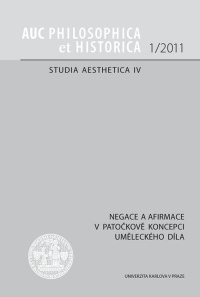Umění minulosti a přítomnosti v Patočkových interpretacích Hegelovy teze o minulém rázu umění
The Presence and the Past of Art in Patočka’s Interpretations of Hegel’s Thesis on the Past Character of Art
Author(s): Miloš ŠevčíkSubject(s): Philosophy
Published by: Univerzita Karlova v Praze, Nakladatelství Karolinum
Summary/Abstract: In this article, the author traces Jan Patočka’s interpretations of Hegel’s thesis on the past character of art. He emphasizes Patočka’s views on the far-sightedness and current relevance of Hegel’s thesis. Patočka argues that Hegel rightly recognized the fundamental difference between classical and contemporary art. He develops Hegel’s view and offers a conception of two periods of the spiritual life of mankind and of two eras of art. The first is called the ‘era of artistic culture’. In this era, art was the predominant way of approaching reality. Divinity was revealed through art, and the human gaze penetrated art directly to the truth. The second is called the ‘era of aesthetic culture’. In this era abstract terms were the predominant tool of approaching reality; a work of art was thus recognized as an independent reality. The viewer dwells on the work of art itself. Patočka supposes that artworks of both the artistic era and the aesthetic era always open up a certain ‘meaning’, which enables the orientation of human existence. The status of this world, however, radically changed from one era to the next. Classical art offered objective and binding meaning, but modern art offers personal or individual meaning. The article points to Patočka’s later reflections on this conception of the development of art and it emphasizes that this conception contains an important discrepancy in the relation between the two periods. On the one hand, Patočka considers the difference of the artistic imitation of binding, objective meaning in the first period and the artistic expression of the personal, individual meaning of the second period. On the other hand, he refers to the ontological origin of the artworks of both periods. The article points out that such an ontological relation tends to be suppressed in Patočka’s considerations of the two periods of art. The article also considers Patočka’s temporal interpretation of Hegel’s thesis. From the perspective of this interpretation, art reveals temporality as such, that is, the ontological fundament of the revelation of meaning. The article emphasizes that such an interpretation demonstrates the ontological relevance of the artwork in greater detail. Also in this context, however, Patočka continues to use the concept of the artistic era and of the aesthetic era, though he does not sufficiently clarify the relation between the two eras. The article points out that the discrepancy in the concept of the two eras of art can be resolved with the help of Patočka’s later reflections on the ‘problematic nature’ of meaning. The article argues that in classical art such a nature is concealed, whereas in modern art it is revealed again.
Journal: Acta Universitatis Carolinae Philosophica et Historica
- Issue Year: IV/2011
- Issue No: 1
- Page Range: 75-94
- Page Count: 20
- Language: Czech

